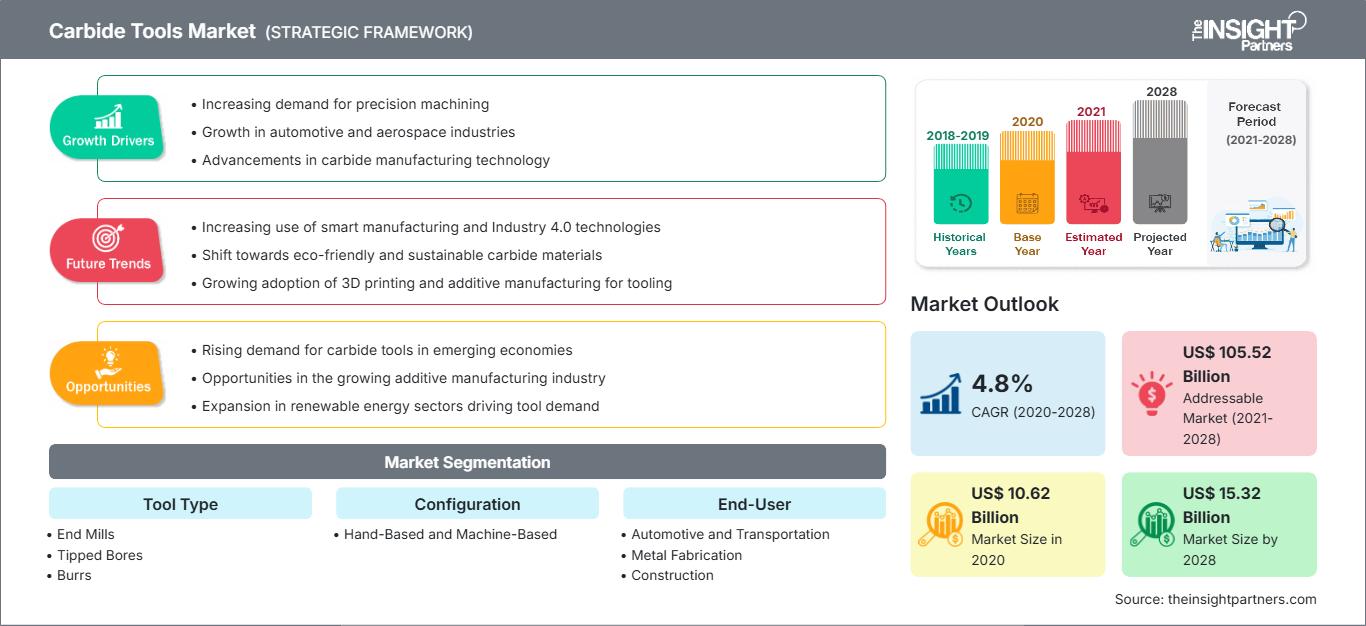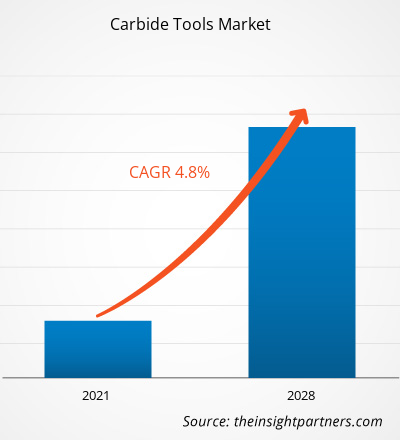[研究报告]2020年,硬质合金刀具市场规模为106.2397亿美元,预计到2028年将达到153.2099亿美元;预计2021年至2028年的复合年增长率为4.8%。
制造业设计的不断发展以及对提高生产效率日益增长的需求,为制造商研究更先进的机床产品奠定了基础,从而推动了对硬质合金刀具的需求。各行各业使用的机床主要用于加工或成型金属或其他硬质材料,并通过镗孔、磨削、剪切和切割等工艺使其具有独特的形状。目前,不同行业广泛使用的机床主要有两种:高速钢 (HSS) 和硬质合金刀具。这些刀具因其显著特点(例如速度快、循环时间短、使用寿命长、在高加工温度下仍能保持切削刃以及切削刃具有出色的耐磨性)而被广泛应用于机械加工领域。硬质合金刀具的日益普及,尤其是在制造业中的应用,是预测期内有望推动市场增长的重要因素之一。此外,这些硬质合金刀具还广泛应用于汽车、航空航天、铁路、家具和木工、能源和电力以及医疗设备等行业的制造部门。在这些行业中,专用切削刀具用于设计和制造产品,这推动了对硬质合金刀具的需求。不同行业纷纷部署硬质合金刀具进行手动或自动操作,进一步推动了全球硬质合金刀具市场的增长。
自定义此报告以满足您的要求
您将免费获得任何报告的定制,包括本报告的部分内容,或国家级分析、Excel 数据包,以及为初创企业和大学提供超值优惠和折扣
硬质合金刀具市场: 战略洞察

- 获取本报告的主要市场趋势。这个免费样本将包括数据分析,从市场趋势到估计和预测。
新冠疫情对硬质合金刀具市场的影响
您将免费获得任何报告的定制,包括本报告的部分内容,或国家级分析、Excel 数据包,以及为初创企业和大学提供超值优惠和折扣
硬质合金刀具市场: 战略洞察

- 获取本报告的主要市场趋势。这个免费样本将包括数据分析,从市场趋势到估计和预测。
新冠疫情已对多个行业造成冲击。病毒传播的迅猛增长促使世界各国政府对车辆和人员流动实施严格限制。由于旅行禁令、大规模封锁和企业倒闭,疫情对各国经济和无数行业造成了不利影响。封锁措施导致商品、货物和服务产量下降。因此,制造业、汽车业、半导体和电子业、石油和天然气业、采矿业、航空业和其他行业由于暂时停工而业务运营出现下滑。
为最大程度地减少病毒传播而实施的全球封锁严重扰乱了供应链活动以及许多制造商(尤其是中小企业主)的生产量。此外,2020 年多个行业的生产活动大幅萎缩,导致硬质合金刀具市场下滑。然而,随着医疗保健产品需求的不断增长,医疗行业对硬质合金刀具的需求也在激增。
硬质合金刀具市场洞察:汽车行业产量增长推动硬质合金刀具市场增长
全球汽车产量持续增长,尤其是在亚洲和欧洲国家,这推动了对硬质合金刀具的需求。该行业广泛使用硬质合金刀具进行曲轴金属加工、面铣和孔加工,以及汽车零部件制造中的其他加工操作。汽车行业通过在球头、制动器、高性能车辆的曲轴以及其他承受高强度使用和极端温度的车辆机械部件中使用碳化钨,取得了优异的效果。奥迪、宝马、福特汽车公司和路虎揽胜等汽车巨头为硬质合金刀具市场的增长做出了重大贡献。混合动力电动汽车在北美越来越受欢迎,从而推动了该地区硬质合金刀具市场的增长。美国和加拿大等国家是该地区著名的汽车制造商。根据美国汽车政策委员会的数据,汽车制造商及其供应商对美国 GDP 的贡献约为 3%。通用汽车公司、福特汽车公司、菲亚特克莱斯勒汽车公司和戴姆勒是北美主要的汽车制造商。根据国际汽车制造商组织的数据,2019 年,美国和加拿大分别生产了约 2,512,780 辆和约 461,370 辆汽车。此外,硬质合金刀具在铁路、航空航天和国防以及海洋工业中也得到了广泛的应用。
基于刀具类型的市场洞察
根据刀具类型,硬质合金刀具市场细分为立铣刀、钻头、毛刺、钻头、铣刀和其他刀具。 2020 年,立铣刀细分市场占据了最大的市场份额。
基于配置的市场洞察
根据配置,硬质合金刀具市场分为手工刀具和机加工刀具。2020 年,机加工刀具占据了更大的市场份额。
基于最终用户的市场洞察
按最终用户划分,硬质合金刀具市场可细分为汽车和运输、金属制造、建筑、石油和天然气、重型机械以及其他最终用户。2020 年,汽车和运输细分市场占据了最大的市场份额。
硬质合金刀具市场的参与者采用合并、收购和市场举措等策略来保持其市场地位。以下列出了一些主要参与者的进展:
- 2020年11月,GARR TOOL 与 Mastercam 建立合作伙伴关系,在 Mastercam 平台内为客户提供完整的刀具库。随着制造流程越来越依赖于即时且便捷的数据访问,此次合作将对现有和未来的客户产生巨大的价值。
- 2019年2月,CERATIZIT 集团收购了 Stadler Metalle GmbH & Co. KG 50% 的股份。该公司表示,对 Stadler 的投资使其能够确保整个原材料供应链的安全,并在原材料供应中更加注重硬质合金刀具的回收利用。
硬质合金刀具市场
The Insight Partners 的分析师已详尽阐述了预测期内影响硬质合金刀具市场的区域趋势和因素。本节还讨论了北美、欧洲、亚太地区、中东和非洲以及南美和中美洲的硬质合金刀具市场细分和地域分布。
硬质合金工具市场报告范围
| 报告属性 | 细节 |
|---|---|
| 市场规模 2020 | US$ 10.62 Billion |
| 市场规模 2028 | US$ 15.32 Billion |
| 全球复合年增长率 (2020 - 2028) | 4.8% |
| 历史数据 | 2018-2019 |
| 预测期 | 2021-2028 |
| 涵盖的领域 |
By 刀具类型
|
| 覆盖地区和国家 | 北美
|
| 市场领导者和主要公司简介 |
|
硬质合金刀具市场参与者密度:了解其对业务动态的影响
硬质合金刀具市场正在快速增长,这得益于终端用户需求的不断增长,而这些需求的驱动因素包括消费者偏好的不断变化、技术进步以及对产品优势的认知度不断提高。随着需求的增长,企业正在扩展产品线,不断创新以满足消费者需求,并抓住新兴趋势,从而进一步推动市场增长。

- 获取 硬质合金刀具市场 主要参与者概述
- 立铣刀
- 尖头镗孔
- 毛刺
- 钻头
- 铣刀
- 其他刀具
按配置
- 手工加工
- 机器加工
按最终用户
- 汽车和运输
- 金属加工
- 建筑
- 石油和天然气
- 重型机械
- 其他最终用户
按地理位置
- 北美美洲
- 美国
- 加拿大
- 墨西哥
- 欧洲
- 法国
- 德国
- 意大利
- 英国
- 俄罗斯
- 欧洲其他地区
- 亚太地区(亚太地区)
- 中国
- 印度
- 韩国
- 日本
- 澳大利亚
- 亚太地区其他地区
- 中东和中东地区非洲 (MEA)
- 南非
- 沙特阿拉伯
- 阿联酋
- MEA 其他地区
- 南美洲 (SAM)
- 巴西
- 阿根廷
- SAM 其他地区
公司简介
- 新瑞实业有限公司
- CERATIZIT SA
- GARR TOOL
- Ingersoll Cutting Tool Company
- KYOCERA Precision Tools
- DIMAR GROUP
- MITSUBISHI MATERIALS Corporation
- Sandvik Coromant
- YG-1 Co., Ltd.
- Makita Corporation
- 历史分析(2 年)、基准年、预测(7 年)及复合年增长率
- PEST和SWOT分析
- 市场规模、价值/数量 - 全球、区域、国家
- 行业和竞争格局
- Excel 数据集
近期报告
客户评价
购买理由
- 明智的决策
- 了解市场动态
- 竞争分析
- 客户洞察
- 市场预测
- 风险规避
- 战略规划
- 投资论证
- 识别新兴市场
- 优化营销策略
- 提升运营效率
- 顺应监管趋势




















 获取免费样品 - 硬质合金刀具市场
获取免费样品 - 硬质合金刀具市场